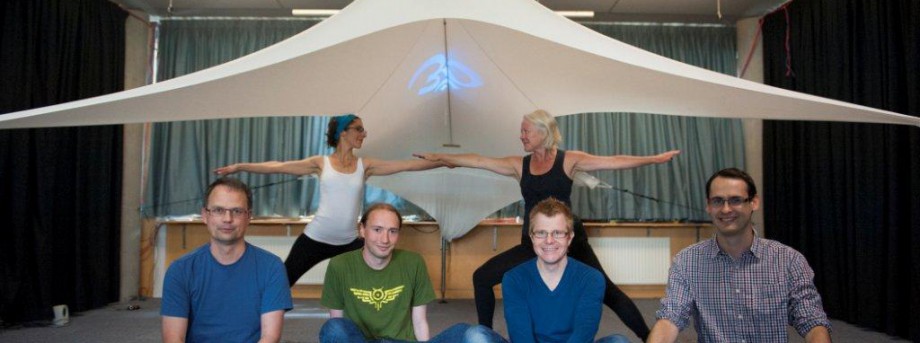The University of Nottingham
 Exchange online
Exchange online
Research Exchange
Breathing new life into the yoga experience

A unique new architectural environment for people who practice yoga and meditation is planning to take this ancient discipline into the digital era.
‘ExoBuilding’ is a piece of adaptive architecture which has been designed and built by a team of scientists and architects at The University of Nottingham. The project has been pioneered by the University’s Mixed Reality Lab, which creates interactive technologies to enhance everyday life and is partially supported by the EPSRC Orchid project and the Horizon Digital Economy Hub.
‘ExoBuilding’ is a tent-like structure that changes its height, volume and shape according to its inhabitant’s real-time physiological data. Occupants are wired up to heart and breathing monitors and the structure is driven by servomotors that receive and translate the signals through a platform called the Equator Component Toolkit, also designed at Nottingham.
Initial testing and research on the effect of this physiologically-driven smart environment revealed some striking reactions from users in the form of slowed breathing rates and improved heart rate patterns. This resulted in a general feeling of relaxation. The potential application of ExoBuilding in the field of yoga is now being tested by the team, with help from a university psychologist and yoga expert.
ExoBuilding’s designer, architect Dr Holger Schnädelbach said: “Adaptive architecture is concerned with buildings or structures that are designed to adapt to the people using them. Modern buildings are becoming infused with sensors measuring a variety of data streams about the environment, people and objects. ExoBuilding is a logical extension of this trend which uses biofeedback from standard medical monitoring devices to give the user a certain level of control of the structure around them. We are quite excited about the potential scalability and varied uses of this project in the context of the ‘Internet of Things’.”
A yoga club based at the University’s Institute of Mental Health has been enlisted to test ExoBuilding and results are so far encouraging. Yoga leader and research psychologist Dr Elvira Perez-Vallejos said: “For yoga practice, I think the ExoBuilding is an incredible tool. A key aspect of yoga is breathing and the interactive structure is like an outward visual and aural manifestation of that physiological process. There is a lot of evidence that yoga can help people with mental health problems and I think this prototype has huge potential in this area of healthcare and wellbeing.”
Research fellow in Computer Science and yoga practitioner Dr Stuart Moran added: “One of the interesting things about this project is that it brings a level of real-time objectivityof ‘science’, to yoga which is quite in contrast to the usual perceptions of yoga as a purely spiritual practice. It is ‘science meets spirituality’ and quite a unique research avenue.”
PhD student in the Mixed Reality Lab, Nils Jäger, added: “Our yoga experiments are still a work in progress but initial results suggest this interactive environment can greatly enhance its practice and teaching. We would like to eventually scale up ExoBuilding to examine its potential for creating and sustaining group cohesion for multiple users. Additionally, this research gives us detailed insights into the relationship between the human body and digitally-driven architecture.”
A video on the ExoBuilding project is available here.
Tags: Adaptive architecture, architect, architectural environment, Dr Elvira Perez-Vallejos, Dr Holger Schnädelbach, Dr Stuart Moran, EPSRC Orchid project, ExoBuilding, Horizon Digital Economy Hub, Institute of Mental Health, Mixed Reality Lab, physiological data, servomotors, yoga experience
Leave a Reply
Other News

Top prize for quantum physicist
A University of Nottingham physicist has won a prestigious medal from the Institute of Physics for […]

Zero carbon HOUSE designed and built by students comes home
Design and construct a low cost, zero carbon, family starter home, transport it to Spain, build […]